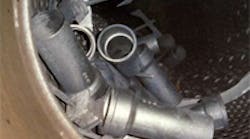In most foundries, the primary source of airborne silica dust is the vibrating shakeout and the sand carryover, along with the sand that remains attached to castings after shakeout. When a green-sand mold is dumped onto a conventional vibrating shakeout, a large amount of fine silica dust is released into the plant.
The amount of sand released is directly related to the sand temperature at shakeout. When the average sand temperature exceeds 100°C, convection carries silica dust into the atmosphere. The higher the sand temperature at shakeout, the greater will be the convection current velocity, and the amount of steam and dust to be captured. With a sand-to-metal ratio below 6.9:1, the average sand temperature will exceed 100°C. Convection current velocities increase significantly from 100° to 200°C.
The heat-affected zone of the mold is the area where molten metal comes into direct contact with the sand grains (mold face). As the sand expands in this zone, internal stresses cause weak grains to fracture. As the quality of the sand varies around the globe, the source of supply has direct impact upon fines generated, from both mechanical and thermal aspects.
Here’s another important calculation: for every kilo of metal poured into the mold, 15% by weight of new sand should be added to replenish the losses and keep the sand system in balance. Because the amount of cores varies from job to job, using core sand as new sand additions is a hit-or-miss approach unless it is separated from the green sand and then metered back in at a given rate.
The second source of airborne silica dust is sand still attached to castings after shakeout (in pockets, cavities, and corners.) As heat from the metal drives out the moisture, loose sand falls off and contaminates downstream operations. Workers in cleaning, finishing, and melting departments are exposed to this silica dust.
The next source of dust is sand in castings entering the shot-blasting process. That sand not only accelerates equipment wear but also is degraded and added to the waste stream — which increases sand disposal costs. The sandy, un-shotblasted returns to remelt lower melting efficiency and increase slag, slag handling, and slag disposal costs.
Didion International Inc.’s (www.didion.com) latest invention is the new Mark 5 Series rotary media drum that performs shakeout, sand conditioning, double sand screening, casting cleaning, and casting cooling in one efficient step, so the foundry stays cleaner with less airborne silica dust. Combining these processes can save a foundry $40-80/ ton, and according to Didion the patented design has the industry’s lowest operating cost per ton worldwide.
Foundries get several benefits: less capital equipment purchased and space occupied; lower energy costs, maintenance time/costs, and shot consumption; fewer replacement parts; cleaner working conditions; and cleaner returns to remelt, reducing slag build-up.
The new Mark 5 streamlines production, with cooled, clean castings going directly to finishing. Return sand is blended and conditioned so temperature and moisture content are consistent, for better control at the mixer. The sand stays in the system, so the foundry is cleaner. Dust collection is efficient due to the small open area of the drum. The Mark 5 requires 75% less dust collection than a vibrating shakeout rated at the same capacity. Counterflow air eliminates fugitive emissions, protecting workers from airborne silica dust.
The Mark 5 is the only shakeout system that separates core sand from green sand and discharges each at separate points. The machines have variable-speed drives so the operator controls the action. The media bed protects nonferrous and fragile castings as it cleans and cools them. Custom linings are available for aluminum, brass, malleable gray, ductile, and steel castings. Installations include green sand, shell, no-bake, and lost foam systems.
Recent improvements in the Mark 5 Series include interlock liners that are thicker and wider for longer life, 50% fewer seams, and contoured rifling for delicate castings, self-relieving tapered separation chambers, split pillow block endtrucks with quick-change bearing inserts, and automatic chain tensioning.
System improvements include water quenching directly after the machine to avoid long cooling conveyors, further saving equipment costs, energy, time, and space. For plants using casting baskets and stage cooling, water quenching after the rotary drum can streamline production flow and eliminate bottlenecks in the cleaning room.









